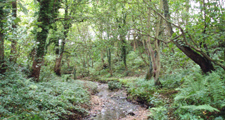Coastal Limestone Plateau
Land Management
Natural Features, Watercourses and Wetlands
- Conserve and restore field and farmyard watering ponds. Remove silt and rank vegetation after taking specialist ecological advice.
- Create permanent grassland buffers in arable fields. Limit stock access to part of the pond perimeter in pasture.
Farmland
- Restore former limestone grasslands on localised limestone outcrops by reversion from arable or by diversifying improved pastures. Use seed or hay crops from local sources.
- Conserve and enhance existing semi-improved neutral grasslands. Adopt appropriate stocking levels or cutting regimes to maximise their biodiversity and avoid improvements such as drainage or reseeding. Limit the use of fertilisers and herbicides.
- Create new species rich grasslands on suitable sites, and particularly where they buffer, extend or link existing semi-natural habitats – and particularly ancient woods and old pastures.
- Protect and conserve semi-natural plant communities in abandoned quarries, road verges and waste ground.
- Establish uncultivated margins along hedgerows, woodland edges, ponds and watercourses. Avoid cultivation under the canopy of hedgerow trees.
- Enhance the biodiversity of golf courses and recreation grounds by increasing the extent of rough grassland, relaxing mowing regimes and reducing the use of fertilisers and herbicides.
Trees, Woodlands and Forestry
- Protect and conserve ancient dene woodlands.
- Progressively remove non-native species like softwoods, sycamore and beech from replanted or modified ancient woods and restock using natural regeneration or planting native species of local origins.
- Plant new native ash (limestone outcrops) and oak (boulder clay) woods in denes and sheltered valleys to buffer and extend existing woodlands.
- Plant new community woodlands on settlement edges in sheltered locations.
- Protect and maintain hedgerow trees in sheltered areas where they occur. Avoid close cultivation, physical damage or spray drift.
- Plant new hedgerow trees (Ash, Common Oak) in sheltered areas and particularly in areas of timbered estate farmland – or tag saplings – to replace the maturing stock.
Field Boundaries
- Protect and maintain hedgerows. Renovate gappy hedges by laying or coppicing and gapping up.
- Allow trimmed hedges to grow higher and broader. Consider trimming every second or third year rather than annually.
- Reinstate hedges where they have been replaced by fences. In areas bordering the coast consider removal of fences to create more open grasslands.
- Reinstate hedges where the hedgerow network has been fragmented by the amalgamation of arable fields and particularly where field sizes are very large or where new hedges would connect other habitats
Cultural Features
- Protect archaeological features including rigg & furrow from damaging activities such as cultivation or poaching by stock.
Development
Agricultural Buildings
- Site new farm buildings close to existing buildings where possible, and reflect their scale, character and materials. Avoid prominent locations like low hills and knolls. Reduce the impact of larger modern buildings by careful selection of colour, breaking up mass and planting screening belts of native species.
Energy, telecommunications & infrastructure - Site communications masts on buildings in urban areas where possible – or close to existing buildings, tree groups or woodland edges in the open countryside.
- Give careful consideration to the siting, layout and design of new wind energy developments having particular regard to cumulative impacts and the relationships of nearby developments in terms of turbine size and type.
- Avoid locating large turbines close to existing rural features such as farmsteads that might emphasise their scale.
- Avoid locating large turbines on or close to discrete landforms like low hills and knolls as this will diminish their perceived scale.
- Take account of visual impacts on adjacent landscapes – particularly the Heritage Coast.
- Avoid ‘urban’ detailing and street lighting on country roads.
Housing and Economic Development
- Maintain the separation of towns and villages and the rural character of the countryside between them in planning for new development.
- Screen any new development with substantial structure planting of native oak or ash woodland or coastal scrub.
Minerals and Waste
- Avoid damage to sensitive natural landforms, mature landscape features and semi-natural habitats in selecting and operating mineral sites.
- Restore quarry faces to naturalistic profiles using restoration blasting.
- Restore quarries and landfill sites to native ash woodland, calcareous or neutral grassland, wetland and bare rock habitats. Retain areas of disturbed ground, cliff faces, scree slopes and quarry wastes to maximise botanical diversity.
- Minimise visual impacts in the working of quarries through careful site design and the use of on and off-site structure planting, road and path side hedges.
- Adopt low intervention approaches to the reclamation of former colliery and industrial land where possible to preserve the landscape’s industrial heritage and ‘brownfield’ biodiversity.
Tourism and Recreation
- Tourism and recreational development should be undertaken in such a way as to avoid any urbanising influence on the landscape.
- Golf course development should seek to conserve and reinforce landscape character by retaining mature landscape features and planting new native woodlands and parkland trees. Avoid prominent locations for built elements like buildings, driving ranges and ball-trap fencing. Develop limestone or neutral grassland in roughs to increase biodiversity.
- Equestrian facilities should be sited close to existing farm buildings where possible, and reflect their scale, character and materials. The impact of larger buildings should be reduced by careful selection of colour, breaking up mass, and planting screening belts of native woodland.
Further Information
- Description of Coastal Limestone Plateau Landscape Character
- East Durham Limestone Plateau Strategy
- Broad Landscape Types Guidelines



